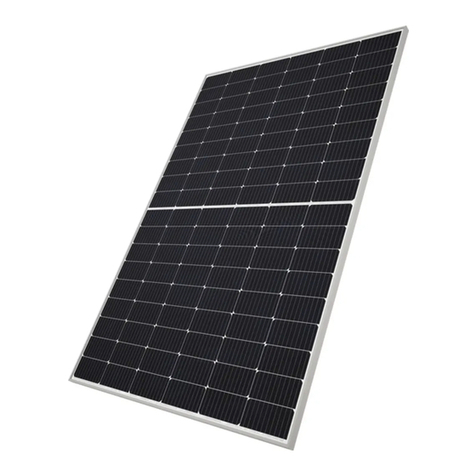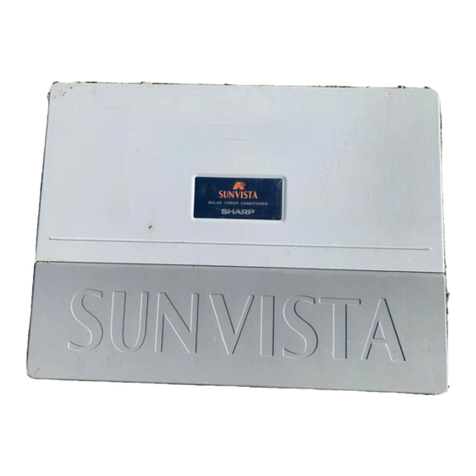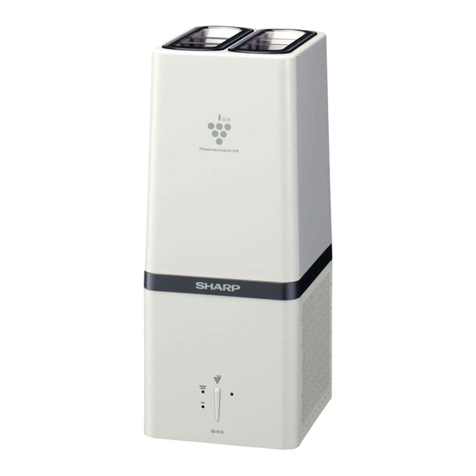
WARNING
Always follow OSHA guidelines.
Solar modules are installed on rooftops where there is
danger of personnel falling off of the roof. Scaffolding,
stepladders, and ladders may be dangerous and require
caution. The installation of solar modules involves work
in high places; take extreme precautions to avoid falling
from roof. To prevent accidents, safety regulations must
be observed. Always take the following precautions to
prevent accidents and injury.
1 Take the following precautions before starting work.
• Plan the job and visit the site before starting work.
• On site, do not work alone. Always work with at
least one other person.
• Inspect power tools before using them.
2 When conditions make it necessary, tell workers
to stop working.
• When it is raining, or there is a strong probability
that it will start raining.
• Immediately after rain, and when work areas are
slippery.
• When high wind conditions exist, or are expected,
or when a high wind warning has been issued.
• When it is snowing, or when there is snow
underfoot.
• When the condition of the scaffolding and ladders
is not satisfactory.
3 Wear appropriate work clothes and protective
equipment.
• Work clothes for both the upper and lower body
should fit well and allow you to move freely.
• Always wear protective equipment such as
harnesses and lifelines.
• Wear a helmet and secure it correctly.
• Wear non-slip shoes. Shoes get dirty when worn
on a roof, so keep the soles clean.
4 Observe safety regulations for ascending and
descending ladders and stepladders.
• Before use, always inspect ladders and stepladders
to makes sure they are in good condition.
1.2 SRS MOUNTING SYSTEM
• Choose a safe spot to anchor ladders and
stepladders.
• Always work with a partner. One person should
hold the ladder steady.
• Ladders from a first-story roof to a second-story
roof are very dangerous. Do not set up a ladder
on a roof. When there is no other choice, straddle
the ridge and lay down a rubber anchor mat, and
secure the ladder to the mat. Always have one
person hold the ladder firmly.
• When you use a two-stage ladder, secure it with
ropes or stays to prevent it from sliding sideways,
and have two people hold the ladder steady.
• Use ladders with steps broad enough to permit
safe work.
5 When working in high places, wear harnesses and
use scaffolding.
• When working at heights of 6 feet or more, use
scaffolds or other equipment to ensure a stable
work platform.
• Scaffolds should be designed and erected by a
qualified person.
• When it is difficult to erect a stable work platform,
install safety nets, wear harnesses, and take other
measures to prevent falls.
• Regulations mandate the use of harnesses. Fasten
harnesses securely, and check that the length of
lifelines is 6 feet or less.
• Attach the primary support line securely to a
metal fixture installed for that purpose on a ridge
or beam.
6 Install enclosures and covers.
• Install enclosures, guardrails, or covers at the end of
work decks that are 10 feet or more above ground,
at openings, and at other dangerous locations.
• When it is extremely difficult to install enclosures,
guardrails, or covers, or when they must be
removed to work in that location, install a safety
net, wear harnesses, and take other measures to
prevent falls.
1FOR SAFE INSTALLATION WORK
7































